Hone technical skills and develop high altitude leadership experience on the high Andean Volcanoes of Cotopaxi and Chimborazo. From the vibrant metropolis of Quito, to the cloud forests of Banos, and to the soaring altitude of glaciated volcanoes, this 24 day course offers ideal high altitude international guide training.
Course Photos
-

 Cotopaxi from the top of Illinza Norte (16,818')
Cotopaxi from the top of Illinza Norte (16,818')
-
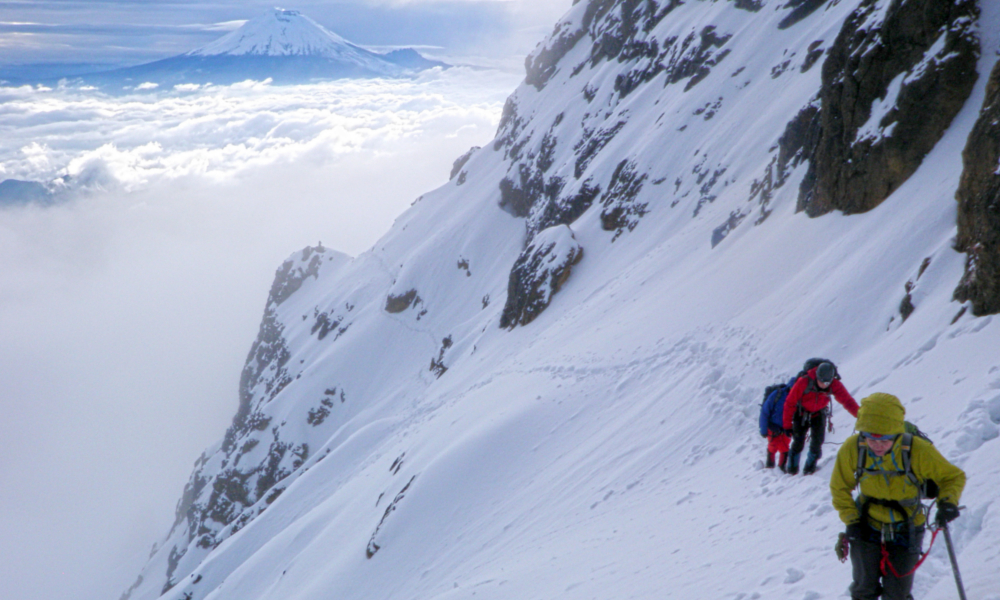
 Crossing the Paso de los muertos on Illiniza Sur after a fresh snow
Crossing the Paso de los muertos on Illiniza Sur after a fresh snow
-

 Rapelling off of the technical section of Illiniza Sur (17,218')
Rapelling off of the technical section of Illiniza Sur (17,218')
-
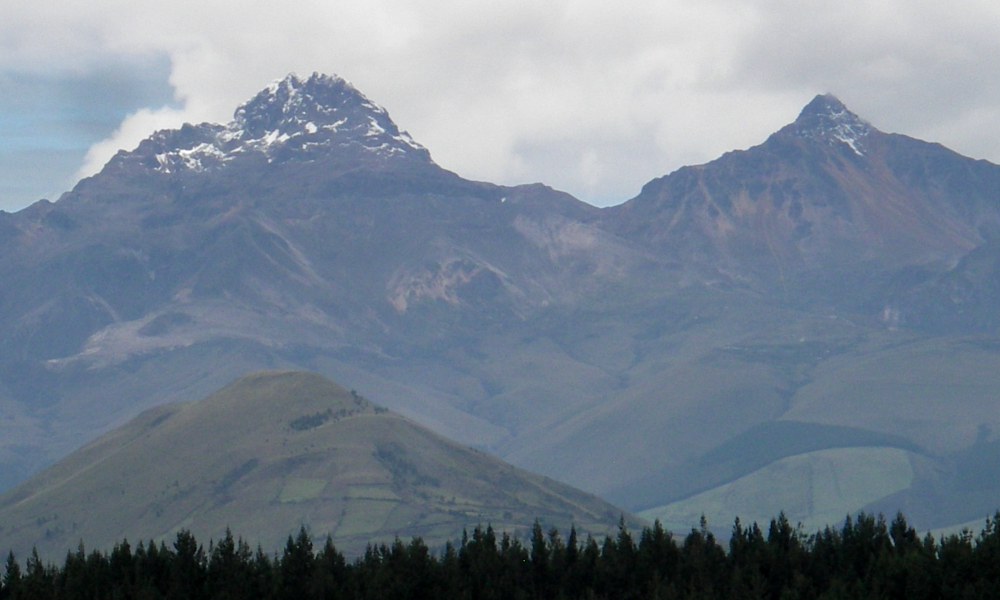
 Illiniza Norte and Sur
Illiniza Norte and Sur
-

 The beautiful eternal spring city of Quito, Ecuador
The beautiful eternal spring city of Quito, Ecuador
-
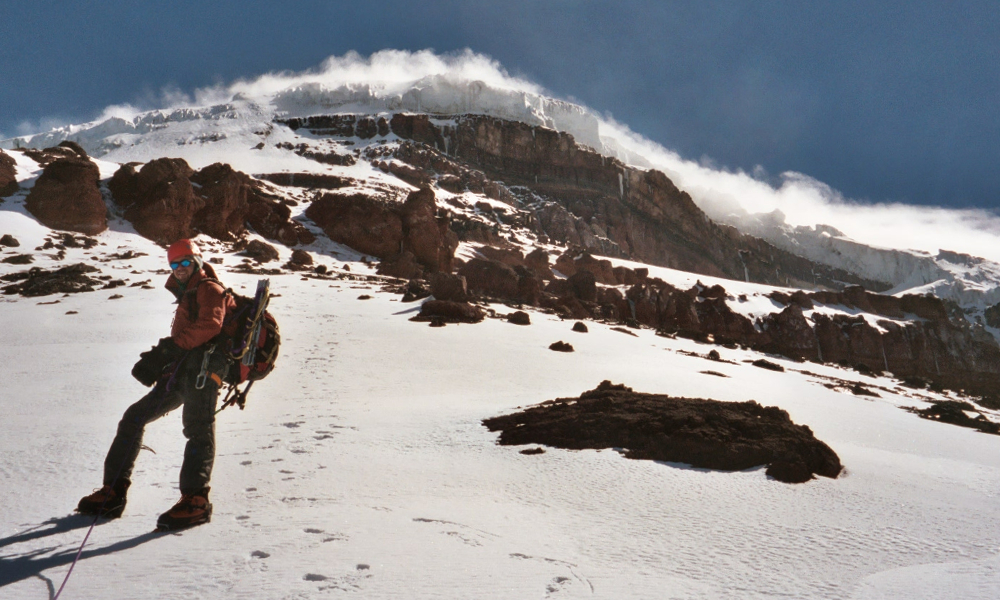
 High on the slopes of Chimborazo (20,564') after a successful ascent.
High on the slopes of Chimborazo (20,564') after a successful ascent.
-
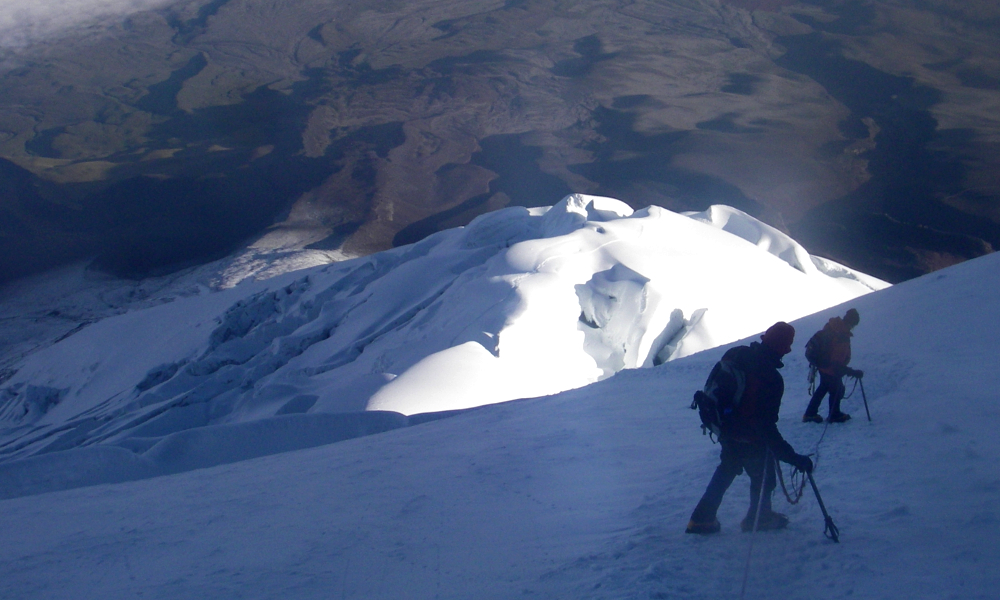

-
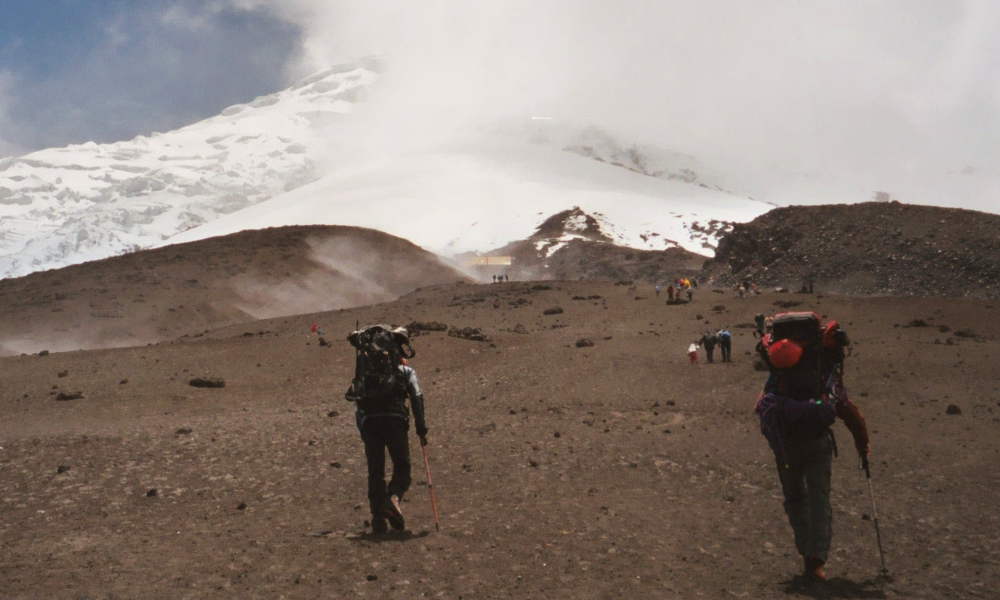
 Ascending towards the refugio on Cotopaxi
Ascending towards the refugio on Cotopaxi
-
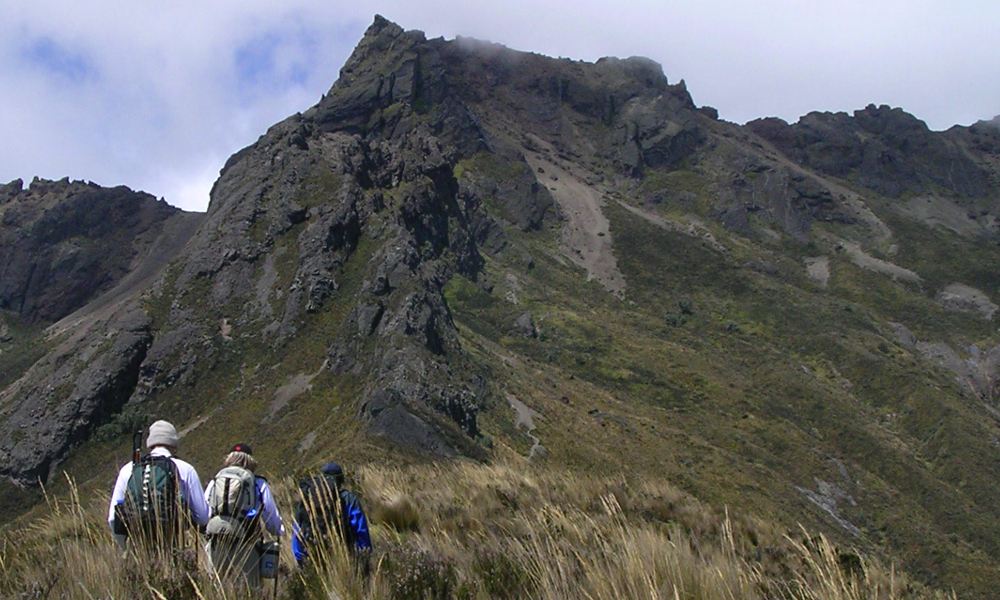
 Acclimatization hike prior to exploring the glaciers of Cotopaxi.
Acclimatization hike prior to exploring the glaciers of Cotopaxi.
-

 Chimborazo (20,564') stands high above the Andean plateau.
Chimborazo (20,564') stands high above the Andean plateau.
Course Notes
Meeting Point: Quito, Ecuador
Destination: Cotopaxi, Chimborazo, Illiniza
Duration: 24 days
Price: $7130 (+ tax, in USD)
Activity Type: Mountaineering
Season: January, February, March
Instructor/Student Ratio: 1 to 3
Technical Skills: high altitude medicine, ice climbing, snow anchors
Leadership Skills: expedition planning, risk management, logistics Max group size: 9 students
Difficulty Level: 5 out of 5
Paperwork Required: Registration, Health Form, travel insurance, Land Based Activity Waiver
Valid passports required
CLICK HERE FOR DATES & PRICES
Trip Description
Natural wonders abound within the small country of Ecuador. Between the remarkable Galapagos Islands and wilderness of the Amazon rainforest, exists the high Andean plateau. The avenue of volcanoes, hosting numerous mountains above 15,000 feet is a backbone of the region, geographically and culturally. The high, glacier strewn volcanoes, offer a perfect setting to learn high altitude mountaineering skills.
Imagine cresting a crevassed ridge to witness the beginning of the equatorial sunrise, assessing the groups’ acclimation trends using a pulse oximeter, or bartering in Spanish for local produce. Picture yourself attempting five summits over 17,000 feet amidst the rich Ecuadorian culture of the high Andes.
The course will start and end in Quito. We’ll explore this city of ‘eternal spring’ nestled in the foothills of the Andes at nearly 10,000 feet. After a few days of acclimatization on the Pichincha Massif and trip planning around Quito, we will travel to Illiniza Norte and Illiniza Sur, situated amidst the avenue of the volcanoes to hone our mountaineering skills. Next we will head north to Cayambe (18,997 feet), the highest point on the equator to further our acclimatization, technical development and high altitude leadership techniques.
Cotopaxi (19,347 feet), one of the classic alpine climbs in the world, brings us high above the Andean plateau for breathtaking views. After a short break in Banos to refuel, we will attempt to climb Chimborazo (20,701 feet). Higher and more technically demanding, ‘Chimbo’ is the culmination of this mountaineering course. The moors, or ‘Paramo’, of the Andean plateau are home to llamas, condors, and a variety of other species. Pre-Colombian ruins dot the landscape and give reference to Incan times. The Ecuadorian culture of today is an assemblage of different cultures and communities extending from the equatorial coast, the high Andean plateau, and the Amazon basin.
This comprehensive mountaineering course is the perfect setting to achieve your goals whether you are looking to become a professional guide, hone your technical abilities for personal adventures, or expand your leadership skills. It focuses on teaching students to be safe, efficient, knowledgeable and confident outdoor leaders in a high altitude glaciated mountain environment.
CLICK HERE TO CHECK OUT DATES & PRICES!
Ecuador: Ecuador can be divided into three distinct geographic regions: the coast, the highlands, and the ‘Oriente’ (Amazon basin). This dynamic country hosts myriad natural wonders from the ice fields of smoking volcanoes to cascading jungle waterfalls.Quito: Quito is the starting and ending place for our trip. Quito, the capital city of Ecuador at 9,000 ft, is a fascinating city on the equator with spectacular mountain views and Spanish colonial architecture.
Illinizas (~17,000'): A great acclimatization region with multiple objectives. Norte offers more basic scrambling with some exposed rock sections and traverses. Illiniza Sur offers more challenging terrain with 70 degree ice pitch and steeper terrain. Both offer great acclimatization and skill development in a seldom visited area.
Cayambe (18,996'): Cayambe is the highest point on the equator, and a great location for glacier trekking, ice climbing and skill development. The robust terrain options offer an incredible classroom, and ideal acclimatization before heading to Cotopaxi or Chimborazo.
Cotopaxi (19,347'): Meaning "neck of the moon" in Quechua, Cotopaxi is often a highlight of the course. Significant glaciation offers access for additional training opportunities, and ongoing route variations from year to year. Summit day is a big day, and sure to test the mettle of students.
Chimborazo (20,564') (: As the highest peak in Ecuador, "Chimbo" is surely a highlight objective for the course. Summit day is the most challenging of the course, and involves over 4,000 vertical feet of climbing. The route involves some consistent 40 degree terrain with a few steeper steps and exposure. Conditions on the mountain aren't always safe to climb, so IWLS may substitute an alternative peak if conditions don't allow for safe climbing.
Climate: The weather in the highlands of Ecuador have been described as an eternal spring. The days tend to be pleasantly warm with the chance of showers in the afternoon. A light sweater normally suffices for the cool evenings in Quito. On the mountains, temperatures are often in the single digits at high elevations in the early morning hours. Temperatures increase drastically throughout the day.
Difficulty: Mountaineering at high altitude can be physically exhausting. Pack weight tends to be low due to the shorter stints and refugios that we utilize, however, the climbing, high altitude and pacing of the course can be demanding and challenging. Previous mountaineering experience is recommended.
Our Instructors: IWLS instructors and guides are highly-trained professionals recognized as some of the best in their field. They have a wealth of experience from guiding throughout Alaska, Canada, and the world. They genuinely enjoy sharing their knowledge of the outdoors in the wild places that they love. Their experiences and leadership help our students to have the best possible experience during their course. Students' safety, education, and enjoyment are their primary goals. The International Wilderness Leadership Schools’ educational model nurtures leadership development and creates an awareness of the guiding mentality that is essential for leading safe, fun adventures in the mountains. The combination of technical skills training, experiential education and practical leadership experience make the IWLS curriculum world-class. Our Aconcagua instructors have extensive experience on the mountain. Their skill and knowledge insure a safe, successful, and fun trip. We also limit the size of our groups and maintain a small student to instructor ratio. The itineraries and camps that we use are designed to provide the best experience on this challenging and rewarding trip!
Experience Level: No previous experience is necessary for this course. However, with a desire to learn and an enthusiasm for adventure, you’ll develop the skills necessary for a lifetime of wilderness exploration. Previous expedition camping and/or high altitude experience is recommended.
Certifications: Upon completion of the 24-day Ecuador Volcanoes Mountaineering leadership course, students will be eligible for the following certifications:
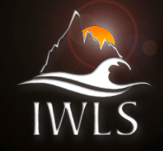 24-day Mountaineering Guide Training Certificate of Completion
24-day Mountaineering Guide Training Certificate of Completion
Course Itinerary (printable PDF version)
Day 0: Arrive in Quito. An instructor will meet you at the airport with an IWLS sign.
Day 1: We will start and finish our course in Quito, the capital city of Ecuador. It is a beautiful city nestled into the foothills of the Andes at an elevation of just over 9,000 ft. Quito is an interesting city with lots of fascinating markets and history to explore.
Day 2: While acclimating, we’ll explore some of the unique cultural sights of the historical district of Quito.
Day 3 - 4: Guagua Pichincha: Located above Quito at an elevation of 15,000 ft, Pichincha offers spectacular views of the area surrounding Quito, and provides for a great acclimatization opportunity.
Day 5: Travel to the Illinizas. We’ll set up camp at ‘La Virgen’ at the trailhead.
Day 6 - 9: Summit attempts of Illiniza Norte (16,790 ft), and Illiniza Sur (17,218 ft). We’ll also spend a day covering skills on the glacier of Illiniza Sur. We’ll establish base camp near the refugio in the saddle between the peaks. On day 9 we’ll catch some well deserved shower time at a hostel in the valley below.
Day 10: Travel north to Cayambe (18996 ft)
Day 11 - 15: Mountaineering skills on the slopes of Cayambe followed by a summit attempt. Cayambe is a great location to cover a wide spectrum of mountaineering skills. With decent rock, ice and snow slopes, we’ll spend 4 solid days covering skills.
Day 15: Mid-course evaluations
Day 16 - 19: Cotopaxi (19,347 ft), summit climb. We’ll recover from our time at altitude with a few nights sleep down in the valley.
Day 19 - 20: We will spend the morning driving to Banos and explore this beautiful town in the mountains. We’ll spend a day at a lower altitude, exploring the cloud forest town of Rio Verde and enjoying the culture of beautiful Banos.
Day 21 - 23: Chimborazo climb (20,697 ft): This is a more challenging climb than Cotopaxi. From the hut we will spend one or two days climbing the route depending on the current conditions. We have scheduled an extra day in to allow for weather, or more acclimatization time. The climbing on Chimborazo can be steep and demanding, although not technical. There are incredible views from the summit!
Day 23: After our climb of Chimborazo, we will drive back to Quito. In the last days of the course we will have final peer and instructor evaluations. Students will be evaluated on their understanding and completion of the IWLS curriculum.
Day 24: Depart Quito
IWLS General Curriculum outlines the essential components for effective outdoor leadership. Here are a few points that your course will focus on.
- Leadership: We not only exemplify leadership – we teach it and implement it. Students will have opportunities to lead the group through a variety of activities, objectives, and responsibilities.
- Safety and Risk Management: Safety is always our #1 consideration. As the course progresses, students will develop an awareness to appropriately assess risk and make safe decisions in and out of the field. Especially as it applies to high altitude.
- Expedition Behavior and Group Dynamics: Because this course is a true wilderness expedition, interactions between group members need to be supportive and contribute to the efficacy of the group. The daily dynamics of the group, combined with guided instruction, will teach students not only how to be a member of a cohesive team, but how to influence and lead an expedition.
- Environmental Ethics: As adventurers in some of the most pristine environments on the planet, it is our duty to respect the natural world. All of our courses practice and teach Leave No Trace® principles.
- Communication Skills: Speaking in public, managing a personal conflict, or leading a group in the wilderness - all of these situations require effective communication. Students will gain confidence in their communication abilities while developing personal leadership styles during this course.
The IWLS Mountaineering Curriculum is built from countless expeditions on Aconcagua, in Alaska, and around the world. You’ll learn how to be a competent and proficient mountaineer in a variety of different environments. Below are some topics we’ll cover:
- Subjective Hazards: Among other things, dehydration, fatigue and personal pride can be detrimental to group safety. Learn how to implement measures to mitigate these potential hazards.
- Short Roping: Learn different applications of short roping technique and times and places to utilize it.
- Altitude Considerations: Aconcagua reaches heights above 22,000 feet. Learn how to recognize signs and symptoms of acute mountain sickness, and steps to take to avoid it. We’ll also discuss the most effective treatment for all altitude illnesses: descent.
- Timing: In the mountains, timing is everything: when to leave camp, when to turn around, and when to push for the summit. Time management is a critical component of safe travel and plays into many aspects of mountaineering.
- Travel Techniques: Course instruction will help you discover ways to safely maximize your efficiency, whether hiking down a well-beaten path or traversing an exposed ridge.
- River and Stream Crossings: In river crossings, attention to detail and safety is paramount. Students will learn and practice safe techniques for wading across a small stream or doing a Tyrolean traverse across a raging river.
- Stoves and Campfires: The ability to repair a broken stove, make an emergency fire after being submerged in an icy river, and melt snow efficiently for water are key components for leading a group in the wilderness.
- Route Finding and Navigation: The Donjek Route often has no obvious trail. Students will learn important fundamentals for route finding, using a compass, and navigating in order to negotiate this remote terrain.
- Camp Skills Learn about the tents we'll be utilizing, how to organize our kitchen and keep our food secure and appropriately protected from bears and other wildlife.
The IWLS International Curriculum is designed to provide students with a fundamental understanding of planning and leading expeditions in foreign countries. Here are just a few topics that will be covered:
- Cultural History: As visitors to this remarkable place, we place a premium on being respectful and learning about the local culture and history.
- Trip Preparation: Logistics in a foreign country can be complex and tenuous. You’ll take part in shopping at the local market, arranging transportation, and securing permits in preparation for your expedition on Aconcagua.
Trip Documents:
- Course Overview- Printable detailed course overview & itinerary.
- Equipment List - Overview of personal clothing and equipment that you'll need for this course.
- Registration Form - Outlines policies, and essential information. One required per participant.
- Health Form - This form enables our guides to have accurate health information in the event of an emergency.
- Land Based Activity Waiver - One required per participant. Guests under the age of 18 may go on one form.
- Travel Info - Helpful information on how to get to/from Argentina.
What is included in the course price:
- Expedition gear - group camping equipment, tents, stoves, etc...
- Expedition food - all food during the course including in the field, refugios, and rest days when we are in other towns in Ecuador.
- Transportation during trip - departure and return to Quito. We cover all park entrance and refugio fees as well.
- Professional instructors - Our leaders have extensive knowledge of the area and a passion for leading in wild places.
Students are responsible for the following:
- Personal clothing & equipment - review the equipment list included under "Documents"
- Food and Lodging in Quito before or after course - IWLS does cover food and lodging starting day 1 through day 24.
- Travel insurance - travel insurance is required for all international programs with IWLS.
- Airfare & travel to course location - review the "Travel Information" under "Documents" for more details.
- Reviewing course policies - please reference our policies page for policies regarding payment, cancellations, refunds and student responsibilities.
- Gratuities
To Book your adventure, follow the steps below:
- Please call to confirm availability at 1-800-766-3396 or fill out an online form to request more information:
- Place a deposit of $500 or 25% of trip cost (whichever is less) to reserve your spot: this can be place over the phone by credit card, check in the mail, or through our payment gateway.
- Once you've reserved your spot, you'll receive a welcome packet with all the necessary registration forms and trip information.
- Be sure to submit all trip registration documents at least 45 days prior to your course. This includes information on your arrival/departure, lodging, dietary, and medical information.
Feel free to call or email anytime if you have questions about your upcoming trip. Our team is excited to help you prepare for your adventure!
Student Comments:
I really enjoyed the combination of Ecuadorian culture and high altitude mountaineering. After each summit, there was opportunity to relax, and experience the people and culture of the Andean plateau. Great instructors, and a great high altitude guide training experience! - Jim P.
